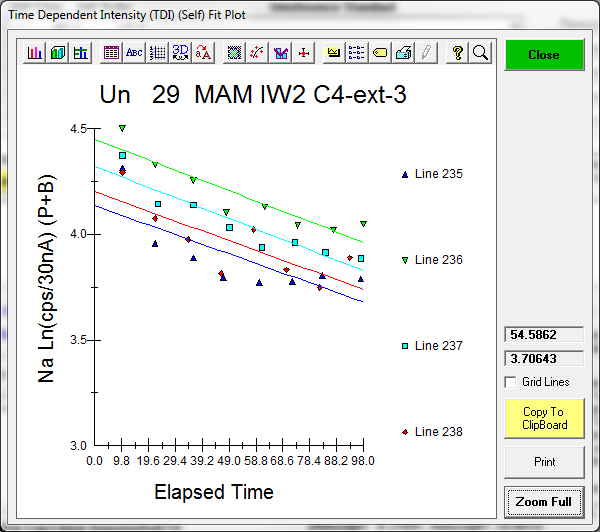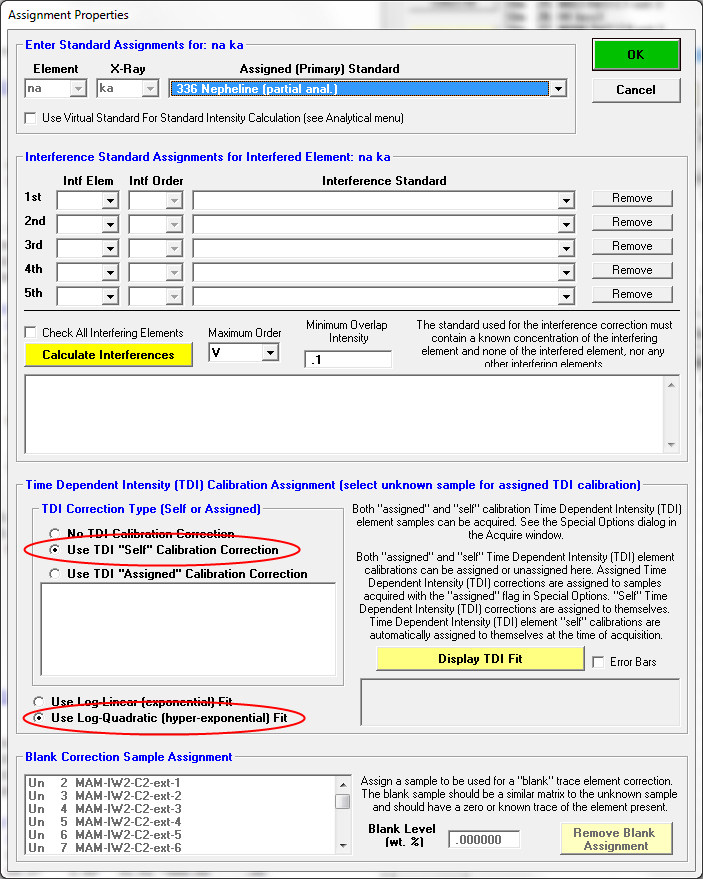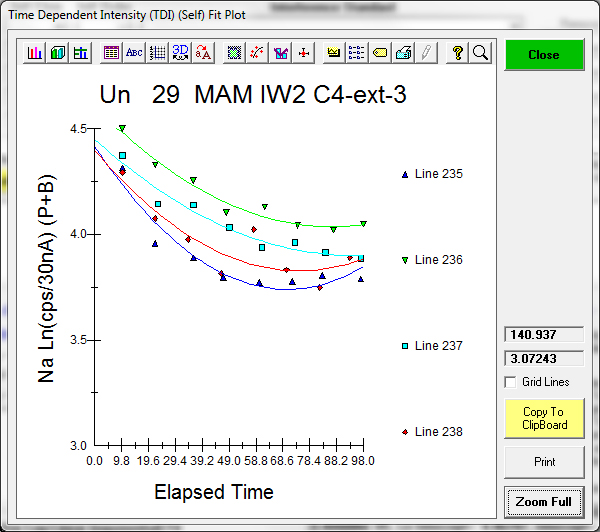The Time Dependent Intensity (TDI) correction for changes in x-ray intensity as a function of acquisition time is well known though not completely understood. The physics of ion migration/volatilization as a function of thermal conductivity, ion mobility and electron dose is complex and very likely convolves together several different physical processes with different time scales.
But for the purposes of correcting for this artifact since the sample is what it is, we are left with reducing beam current, increasing beam diameter, decreasing beam exposure (acquisition) time, cooling the sample cryogenically or some combination of these procedures along with a software correction for these effects which, depending on the element, can result in decreases or increases in x-ray intensity over time.
A typical hydrous glass with a normal (log-linear) TDI correction for Na, Si, Al (and Ca and Ti) is shown here:
ELEM: Na Si K Al Mg Ca Ti Mn Fe P Cr O H
TYPE: ANAL ANAL ANAL ANAL ANAL ANAL ANAL ANAL ANAL ANAL ANAL CALC SPEC
BGDS: MAN MAN LIN MAN MAN MAN LIN LIN MAN EXP LIN
TIME: 80.00 30.00 40.00 40.00 60.00 80.00 20.00 20.00 60.00 60.00 30.00
BEAM: 20.08 20.08 20.08 20.08 20.08 20.08 20.08 20.08 20.08 20.08 20.08
ELEM: Na Si K Al Mg Ca Ti Mn Fe P Cr O H SUM
235 .315 26.882 .449 4.251 5.416 4.877 .925 .343 11.099 .199 .055 44.303 .000 99.113
236 .487 26.014 .526 4.256 1.367 5.613 .932 .344 16.725 .194 .027 42.621 .000 99.107
237 .396 26.547 .455 4.244 4.251 5.551 .907 .344 12.211 .192 .037 43.735 .000 98.870
238 .359 26.017 .452 4.177 2.586 5.918 .892 .359 14.556 .195 .033 42.777 .000 98.320
AVER: .389 26.365 .471 4.232 3.405 5.490 .914 .348 13.648 .195 .038 43.359 .000 98.852
SDEV: .073 .426 .037 .037 1.787 .439 .018 .008 2.507 .003 .012 .799 .000 .373
SERR: .037 .213 .018 .018 .894 .220 .009 .004 1.254 .001 .006 .400 .000
%RSD: 18.77 1.62 7.83 .87 52.49 8.00 2.01 2.18 18.37 1.49 31.81 1.84 .00
TDI%: 27.702 -.037 ---- -.154 ---- -1.026 .563 ---- ---- ---- ---- ---- ----
DEV%: 10.3 .6 ---- 1.1 ---- 2.9 8.2 ---- ---- ---- ---- ---- ----
TDIF: LINEAR LINEAR ---- LINEAR ---- LINEAR LINEAR ---- ---- ---- ---- ---- ----
TDIT: 97.00 48.75 ---- 58.00 ---- 98.75 37.00 ---- ---- ---- ---- ---- ----
TDII: 72.0 10400. ---- 1897. ---- 169. 98.3 ---- ---- ---- ---- ---- ----
As we can see, the TDI % log-linear correction above highlighted in red, is approximately 28% which seems reasonable until one examines the actual extrapolation to zero time, and then a problem is obvious:

Clearly the intensity change over time is more than a simple exponential.
However, by fitting the log intensity to a quadratic and extrapolating again, we obtain the following results as shown below:
ELEM: Na Si K Al Mg Ca Ti Mn Fe P Cr O H
TYPE: ANAL ANAL ANAL ANAL ANAL ANAL ANAL ANAL ANAL ANAL ANAL CALC SPEC
BGDS: MAN MAN LIN MAN MAN MAN LIN LIN MAN EXP LIN
TIME: 80.00 30.00 40.00 40.00 60.00 80.00 20.00 20.00 60.00 60.00 30.00
BEAM: 20.08 20.08 20.08 20.08 20.08 20.08 20.08 20.08 20.08 20.08 20.08
ELEM: Na Si K Al Mg Ca Ti Mn Fe P Cr O H
TYPE: ANAL ANAL ANAL ANAL ANAL ANAL ANAL ANAL ANAL ANAL ANAL CALC SPEC
BGDS: MAN MAN LIN MAN MAN MAN LIN LIN MAN EXP LIN
TIME: 80.00 30.00 40.00 40.00 60.00 80.00 20.00 20.00 60.00 60.00 30.00
BEAM: 20.08 20.08 20.08 20.08 20.08 20.08 20.08 20.08 20.08 20.08 20.08
ELEM: Na Si K Al Mg Ca Ti Mn Fe P Cr O H SUM
235 .436 26.890 .449 4.253 5.421 4.876 .925 .343 11.099 .199 .055 44.359 .000 99.306
236 .584 26.021 .526 4.258 1.368 5.613 .932 .344 16.725 .194 .027 42.665 .000 99.257
237 .461 26.551 .455 4.245 4.253 5.551 .907 .344 12.211 .192 .037 43.766 .000 98.973
238 .450 26.023 .452 4.179 2.588 5.918 .892 .359 14.556 .195 .033 42.818 .000 98.462
AVER: .483 26.371 .471 4.234 3.407 5.490 .914 .348 13.648 .195 .038 43.402 .000 99.000
SDEV: .068 .427 .037 .037 1.789 .439 .018 .008 2.507 .003 .012 .803 .000 .387
SERR: .034 .213 .018 .018 .894 .220 .009 .004 1.254 .001 .006 .401 .000
%RSD: 14.19 1.62 7.83 .87 52.50 8.00 2.01 2.18 18.37 1.49 31.81 1.85 .00
TDI%: 54.831 -.037 ---- -.154 ---- -1.026 .563 ---- ---- ---- ---- ---- ----
DEV%: 5.9 .6 ---- 1.1 ---- 2.9 8.2 ---- ---- ---- ---- ---- ----
TDIF: QUADRA LINEAR ---- LINEAR ---- LINEAR LINEAR ---- ---- ---- ---- ---- ----
TDIT: 97.00 48.75 ---- 58.00 ---- 98.75 37.00 ---- ---- ---- ---- ---- ----
TDII: 87.2 10400. ---- 1897. ---- 169. 98.3 ---- ---- ---- ---- ---- ----
This was accomplished by merely regressing with the "hyper-exponential" fit shown here in the Standard Assignments dialog for Na:

Therefore, one may improve the accuracy of the TDI correction considerably without having to reduce beam current or increase beam diameter, as shown in the "hyper-exponential" fit below:
